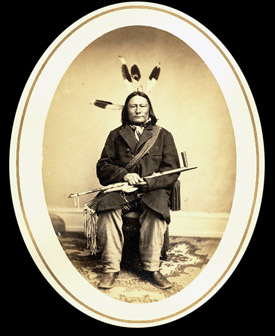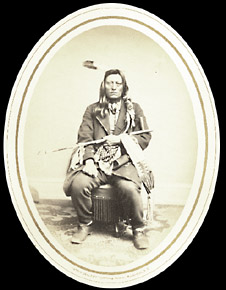
Three Dakota/Lakota men
 During the nineteenth century, Native Americans of the Dakota region became frustrated with the continued pressure from European settlers who, in many cases, had swindled them into debt and forced them to sign treaties that relinquished their lands. Frustration led to the violent conflicts known as the Dakota Wars, which lasted from the 1860s through 1900. In these conflicts, the people known as the Sioux, who called themselves the Dakota or Lakota, fought against the white settlers who attempted to take, rather than merely borrow, the land on which the Dakota lived. The Dakota were, for a time, among the most successful of Native American tribes with regard to their opposition to white settlers. Among their efforts were the well-known 1862 uprising led by Tshe-ton-wa-ku-wa-ma-ni, also known as Little Crow, and the long-term resistance to white invasion by the Dakota chief known as Red Cloud.
During the nineteenth century, Native Americans of the Dakota region became frustrated with the continued pressure from European settlers who, in many cases, had swindled them into debt and forced them to sign treaties that relinquished their lands. Frustration led to the violent conflicts known as the Dakota Wars, which lasted from the 1860s through 1900. In these conflicts, the people known as the Sioux, who called themselves the Dakota or Lakota, fought against the white settlers who attempted to take, rather than merely borrow, the land on which the Dakota lived. The Dakota were, for a time, among the most successful of Native American tribes with regard to their opposition to white settlers. Among their efforts were the well-known 1862 uprising led by Tshe-ton-wa-ku-wa-ma-ni, also known as Little Crow, and the long-term resistance to white invasion by the Dakota chief known as Red Cloud.
As in any war, however, some people assisted those whom their own people considered the enemy. Three of these Dakota men are represented in the photographs of the Antonio Zeno Shindler collection at the APS. All three photographs were taken in Washington in 1867.
MA-TA-WA-YU-MI
Ma-ta-wa-yu-mi (above right), a Yankton man from the Upper Missouri River region, Dakota Territory, became known during the Dakota war as a guide to General Alfred Sully's military expedition. Native Americans who opposed white occupation of the territory shot Ma-ta-wa-yu-mi through the breast, but although he was in an almost dying condition, he guided the entire military force through what whites referred to as the "Bad Lands" of Dakota. The English translation of his name is "The Bear that Frightens."
KAH-KAH-TAH-A-KE-AH and NA-JI-WA-KAN
Kah-kah-tah-a-ke-ah (below, left) and Na-ji-wa-kan (below, right) were two of eleven members of the Two-Kettle (Oehe Numpa) Lakota "Sioux" who recovered two women and six children who had been taken captive. The incident occurred near the mouth of the Grand River in November 1862, on the site of the current Standing Rock Indian Reservation. According to one contemporary source, "hostile Indians" opposed to white occupation had captured Mrs. Julia Fright, Miss Emma Duley, and the children.
The English translation of Kah-kah-tah-a-ke-ah and Na-ji-wa-kan's names are, respectively, "The Flying Bird" and "The Sacred Ghost."
Although Shindler's work provides invaluable documentation of Native Americans in the mid-nineteenth century, the collection is subtly biased in many regards. Shindler included few women among his subjects, and there is a tendency not to represent those who were known as figures of resistance. In part, these omissions were influenced by the availability of subjects in Washington, but it is also possible that Shindler's choice of photographic subjects reflects the bias of white Americans of the era. Native Americans who had assisted whites were considered more suitable photographic subjects than Native Americans who rejected white hegemony. Among the few such figures in Shindler's portfolio are Tshe-ton-wa-ku-wa-ma-ni (Little Crow) and his son Wo-wi-na-pe, and Big-Rib, listed as "second in rank to Red Cloud."
Shindler also documented some of those taken prisoner by the military during the Minnesota "uprising" of 1862, including O-ta-dan, as well as men who were executed, such as Wa-kan-o-than-than. The APS collection of Shindler photographs lacks these latter images.
| Currently on exhibit |
|---|
Book of hours, 15th century
Charter of Privileges, 1701
The Declarations of Independence, 1776
Ben Franklin's jottings, 1783
Louis XVI miniature portrait, 1784
John Cram's fan chair, 1786
Michaux subscription list, 1793
Jefferson's vocabulary, 1802-1808
Lewis and Clark journals, 1803-1806
Peale's mastodon, 1821
|
|
©2006 American Philosophical Society
 During the nineteenth century, Native Americans of the Dakota region became frustrated with the continued pressure from European settlers who, in many cases, had swindled them into debt and forced them to sign treaties that relinquished their lands. Frustration led to the violent conflicts known as the Dakota Wars, which lasted from the 1860s through 1900. In these conflicts, the people known as the Sioux, who called themselves the Dakota or Lakota, fought against the white settlers who attempted to take, rather than merely borrow, the land on which the Dakota lived. The Dakota were, for a time, among the most successful of Native American tribes with regard to their opposition to white settlers. Among their efforts were the well-known 1862 uprising led by Tshe-ton-wa-ku-wa-ma-ni, also known as Little Crow, and the long-term resistance to white invasion by the Dakota chief known as Red Cloud.
During the nineteenth century, Native Americans of the Dakota region became frustrated with the continued pressure from European settlers who, in many cases, had swindled them into debt and forced them to sign treaties that relinquished their lands. Frustration led to the violent conflicts known as the Dakota Wars, which lasted from the 1860s through 1900. In these conflicts, the people known as the Sioux, who called themselves the Dakota or Lakota, fought against the white settlers who attempted to take, rather than merely borrow, the land on which the Dakota lived. The Dakota were, for a time, among the most successful of Native American tribes with regard to their opposition to white settlers. Among their efforts were the well-known 1862 uprising led by Tshe-ton-wa-ku-wa-ma-ni, also known as Little Crow, and the long-term resistance to white invasion by the Dakota chief known as Red Cloud.

